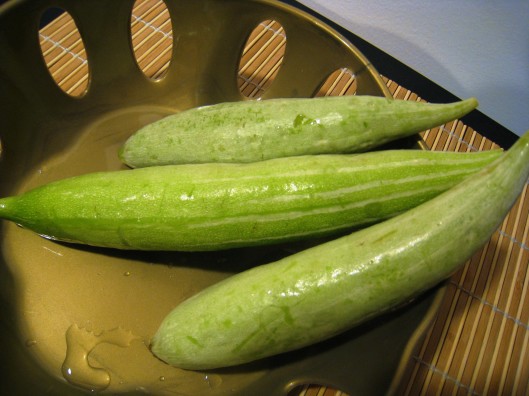The health benefits of snakegourd are rather interesting. Snakegourd juice and leaves are often recommended by experts in natural and alternative medicine for treating some common ailments and problems. Snakegourd is mentioned in ancient Ayurvedic texts for its medicinal properties.
The snakegourd plant (trichosanthes anguina) is a tropical creeper and is usually grown over wooden lattice frames, and the gourds dangle down from a canopy of leaves. Snakegourd (also known as potlakaya, chichinda, padwal in Indian languages) is so-called because it looks like a snake, and can grow anywhere from a foot to six feet in length, sometimes curling in on itself if not stretched out with a stone (or other weight) tied to the end while it’s growing.
Belonging to the cucurbit or cucumber family (pumpkin, bottlegourd, ashgourd), snakegourd is widely grown in India, Sri Lanka, China, Thailand, Nigeria, as well as Australia.
These days a smaller variety of snakegourd is cultivated and widely available in India and in Indian grocery stores in the US. The pale green or dark green with light striped gourd, is bland, or has a slight sweetness, and is absorbent and cooks easily if tender and fresh.
Snakegourd is quite a popular vegetable in Indian cooking. It’s rather bland taste makes it ideal for use with different spices. In North India, snakegourd is usually cooked in dals (lentil soups), while in South India, snakegourd is used in dry and gravy curries, soups, and raitas.
SNAKEGOURD AND HEALTH
According to experts in natural remedies, snakegourd juice has been found effective in treating dandruff. The juice should be massaged into the scalp. This is an easy home remedy for dandruff.
Snakegourd leaves have been found useful in jaundice (hepatitis). An infusion prepared by boiling snakegourd leaves in water combined with an infusion prepared by boiling coriander seeds is given to treat jaundice.
Snakegourd-leaf juice has also been found to be useful in treating palpitations (irregular heartbeat).
Like other gourds such as bottlegourd and ridgegourd, snakegourd is very high in water content and has a cooling effect on the body, hence this summer vegetable that nature provides in such a timely manner helps in handling the summer heat.
Because of its high water content, snakegourd is low in calories, fat-free but filling, and great to include in weight-loss diets.
Snakegourd also contains a lot of fiber which can help keep your digestive tract healthy. The fiber is also helpful for those with diabetes.
Snakegourd is a good source of minerals like magnesium, calcium, and phosphorus.
Cooking Tips
- Pick snakegourd that looks fresh, green, and feels soft but firm when pressed.
- Cook snakegourd with the peel. Tender snakegourds don’t have any seeds, but slightly mature ones do; remove the seeds for a better taste.
- Check for bitterness if the snakegourd is mature.
- Wrap in plastic or place in a plastic bag and refrigerate to keep fresh for 4-5 days.

ReplyDeleteI was diagnosed as HEPATITIS B carrier in 2013 with fibrosis of the
liver already present. I started on antiviral medications which
reduced the viral load initially. After a couple of years the virus
became resistant. I started on HEPATITIS B Herbal treatment from
ULTIMATE LIFE CLINIC (www.ultimatelifeclinic.com) in March, 2020. Their
treatment totally reversed the virus. I did another blood test after
the 6 months long treatment and tested negative to the virus. Amazing
treatment! This treatment is a breakthrough for all HBV carriers.